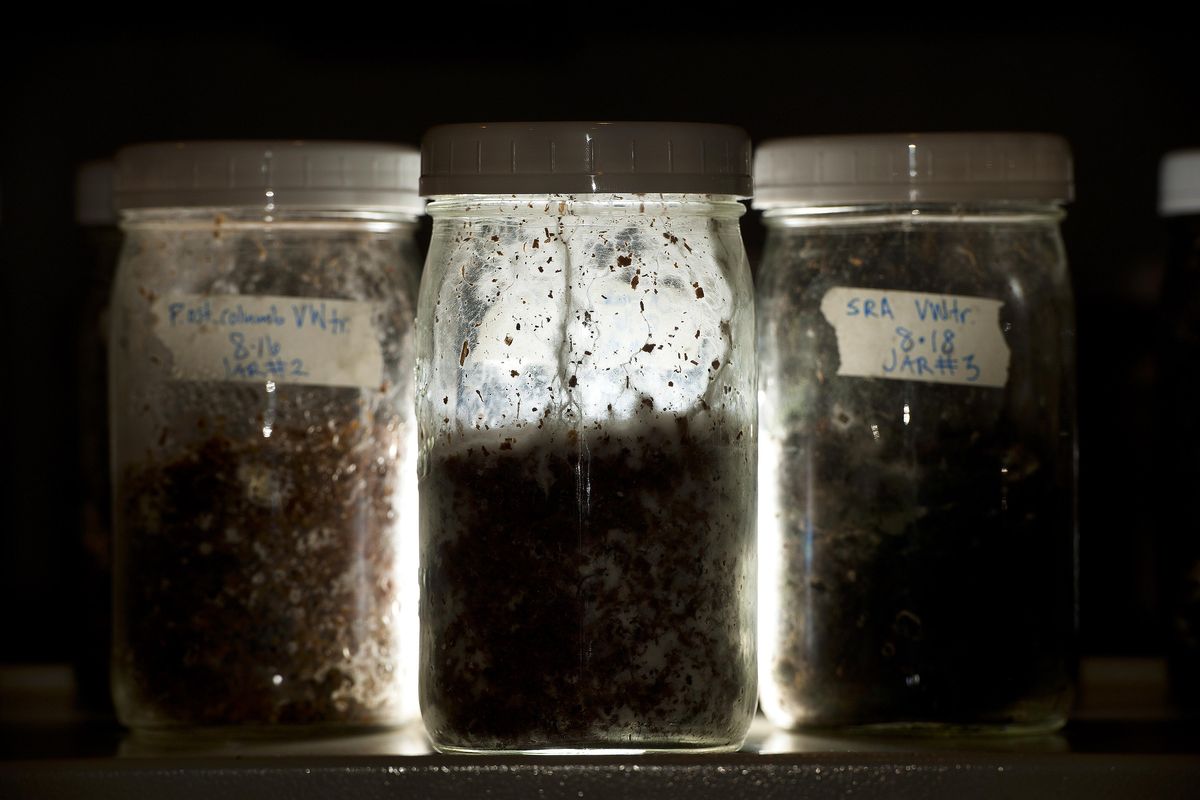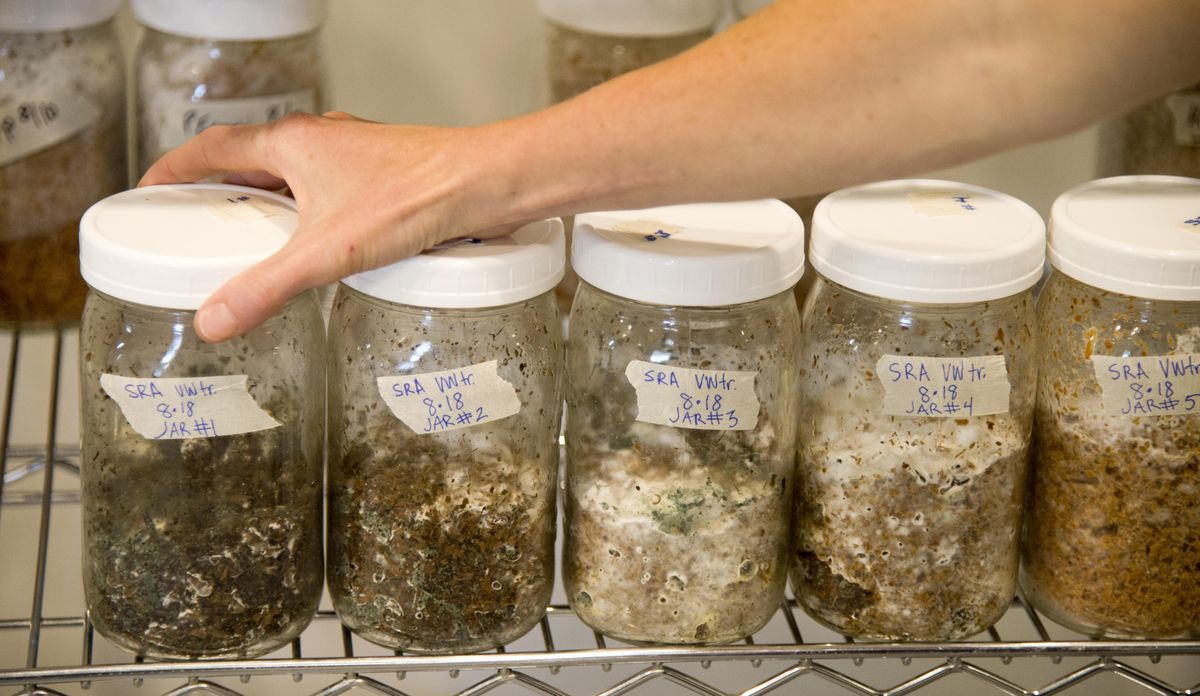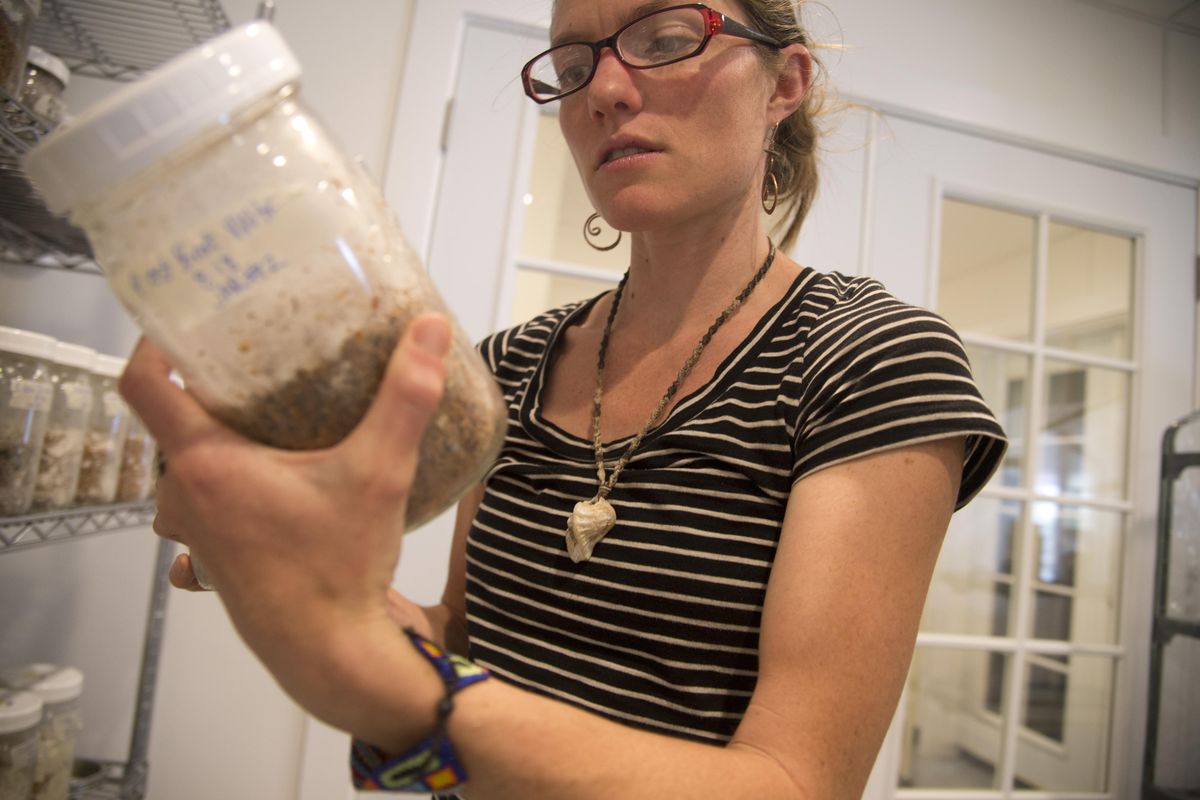Scientist studying mushrooms’ ability to protect Spokane River from PCBs
Researcher Heidi Montez lines up jars in which she is growing various strains of fungus with sawdust, grain or other nutrition sources, along with stormwater sediment, at a small lab built in a storage area in north Spokane on Thursday, Sept. 1, 2016. Montez, who works for the Lands Council, is researching to see if fungus can break down pollutants, specifically PCBs, found in stormwater. (Jesse Tinsley / The Spokesman-Review)Buy a print of this photo
Surveying a shelf of mason jars filled with dirt and fungi, Heidi Montez sounds not unlike a proud parent.
“It’s doing really well. You can see all that white growth is the healthy mycelium,” she said, pointing to a jar holding wild oyster mushroom.
Montez is the scientist behind what may be Spokane’s most innovative approach to treating pollution in the Spokane River.
Her makeshift lab – a sparsely decorated room with a concrete floor in a large warehouse on North Ash Street – is trying to answer an unusual question: Could mushrooms hold the key to removing polychlorinated biphenyls, or PCBs, from the stormwater that drains into the river?
Montez, who works for the Lands Council, is spending a year seeing whether some strains of wood-eating fungi might be able to eat PCBs, breaking them down into harmless carbon molecules.
Her work is funded by a $30,000 grant from the city.
“I don’t know if anyone’s tried to grow mushrooms in storm drain sludge before,” she said.
PCB chemicals hard to get rid of
PCBs are a family of man-made chemicals that were widely used in industrial work from the 1930s until 1979, when they were banned under the Toxic Substances Control Act. The chemicals, which are nonflammable and highly stable, were used as coolants, flame retardants and more.
But PCBs also carry a host of likely health risks. The U.S. Environmental Protection Agency has said PCBs are probable carcinogens, and evidence suggests that PCBs impair the immune system, reproductive system, nervous system and endocrine system.
They’re especially concerning in rivers because they bioaccumulate – building up in the tissues of insects, the fish that eat the insects and the humans who eat those fish.
The chemical properties that made PCBs ideal in industrial use have also made them difficult to clean up. They don’t break down naturally, so cleanup usually means moving them out of the river.
“Most of the time we spend money moving PCBs from one place to another where they’re less problematic,” said Marlene Feist, spokeswoman for the city’s utilities department.
Enter mushrooms.
Studies show mushrooms can break down pollutants
Forest-dwelling species of mushrooms produce enzymes to break down the tough lignin and cellulose molecules that act as structural support for many trees and plants. They’re the organisms that help turn over nutrients in the forest, decomposing dead things so new life can take its place.
“If it weren’t for these mushrooms, we’d be buried in miles of log,” Montez said.
Some of those mushrooms have also shown promise breaking down tough pollutants, like petroleum byproducts and PCBs. A study by Czech scientists, published in the journal Chemosphere in 2012, found eight species of wood-eating fungi were able to break down at least some PCBs, with one species eating upward of 98 percent of the chemical.
“They’re really good at breaking down difficult molecules,” said Mike Petersen, executive director of the Lands Council.
In Spokane, PCBs enter the river through a number of different pathways. Though deliberately manufacturing PCBs is illegal, small amounts of the chemicals are produced inadvertently in many industrial processes involving chlorine, including creating the yellow dyes that go into road paint.
PCBs also remain in the soil at former industrial sites. In both cases, it’s easy for the chemicals to wash into the river through stormwater.
Montez wants to take existing research on mushrooms and PCBs a step further. Her goal is to cultivate strains of fungi that can eat PCBs directly out of the dirt and other solids suspended in stormwater.
She’s long been interested in fungi and has experience growing them for food and other uses. After spending time educating people around Spokane about PCBs in the river, she proposed the research project to Petersen at the Lands Council.
Experimenting with fungi can be a tough sell. Montez knows many people hear the word mushroom and immediately think of psychedelic species or assume fungi can’t have serious applications. Misconceptions like that have made her a passionate advocate for fungi, which she says are among the most poorly understood living things.
Once grouped into the plant kingdom, scientists have since realized fungi are their own group of organisms that are genetically more closely related to animals. Like animals, fungi breathe in oxygen and exhale carbon dioxide, and they eat food rather than photosynthesizing it like plants.
Biologists first proposed fungi as a separate kingdom of organisms in 1959, more than 200 years after scientists began drawing classification trees for living things. The fungi kingdom includes multicellular organisms like mushrooms, as well as single-celled organisms like yeasts and molds.
“People don’t realize that fungi is such a gigantic, diverse group of living things,” Montez said.
Not the kind of mushrooms you eat
Though she refers to the organisms in her research as mushrooms, Montez isn’t growing the fleshy caps people are used to eating. Her petri dishes and mason jars are full of mycelium, the vegetative network of the fungi that usually grows below ground and eats food to keep the organism growing.
She likens the mycelium to the trunk, branches and leaves of an apple tree, while the mushroom itself is the apple.
Her small-scale experiment started with trying to get the mycelium familiar with vactor waste – the technical name for the dirt and sludge removed from stormwater. Montez sterilized the waste so the fungi wouldn’t have to compete with bacteria and other organisms, then mixed some of it into a growing medium in petri dishes.
Mycelium can in theory continue growing forever, so long as they have enough nutrition. Colonies can be transferred from one petri dish to another, continuing to grow a genetically identical organism.
“It’s like cutting off your finger and putting it in a jar … and your finger keeps growing,” Montez said.
After growing a few generations of mycelia in the dishes, Montez moved the fungi into mason jars, growing them with grain, then sawdust: standard, nutrient-rich food for mushrooms.
Finally, starting in August, she began transferring the mycelia to jars with unsterilized vactor waste mixed with sawdust in different concentrations. This is where she’ll be able to see if any of the eight species of mushrooms she’s using can actually break down PCBs using digestive enzymes.
Each species of mushroom had five jars, including a control with no waste.
Because the waste is unsterilized, the mycelium are competing with molds in some jars, but in most cases, they appear to be doing well.
The wild oyster mushroom jars Montez pointed out had tendrils of mycelium stretching out, mirroring the black and brown specks of waste mixed in with sawdust.
“You can see the mycelium actually tracking the vactor waste,” she said.
Promising results could lead to more research
Once the mushrooms have had a few months to grow, the city will pay for testing on the samples that look the most promising.
“I really want to let them go for as long as possible so they really deplete all of their food,” Montez said. “I don’t know if they’re going for PCBs first thing or if they’re waiting.”
Testing will determine what the final PCB concentration in the jars is, and whether the mycelium have actually been eating the chemical.
“We think if we can demonstrate some promise it might be appealing for someone with a larger grant,” said Feist, the utilities spokeswoman.
From there, Montez’s work could have a number of uses.
Feist said the city is excited about the possibility of using mushroom strains to eat existing piles of contaminated waste that have been removed from the river.
Right now, the waste is left to dry out at an industrial site, but it’s not destroyed. PCBs from the waste could end up back in the river if wind blows the chemical away from the containment site.
“What appeals to us is the idea that we can actually break these things down because they’re ubiquitous in the environment,” Feist said.
The city is working to improve stormwater filtration and add more capacity, which would keep PCBs out of the river. Petersen at the Lands Council said fungi could be a next step, eating through that waste to actually remove the harmful chemicals.
The Lands Council would also consider adding promising strains of mushroom to existing storm gardens in the Garland District and creating new ones. The gardens are a collection of native plants designed to filter some harmful chemicals out of stormwater before they get to the river.
In the meantime, Montez is content to spend her days in the lab, taking notes on the progress of her mushrooms.
“This one I just mixed with the vactor waste yesterday, so there’s not a whole lot of growth,” she said, gesturing to a jar of hen-of-the-wood mycelium mixed with sludge and sawdust. “But there’s a little! It’s awake.”









